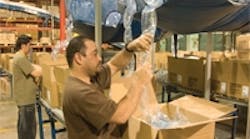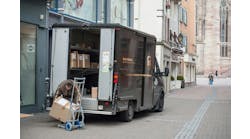Fetco Home Décor, Randolph, Mass., designs, sources, warehouses and distributes tabletop picture frames, decorative wall pieces and photo albums. The company, originally established in 1974, supplies a number of national department and specialty stores in addition to smaller, localized retailers.
During the peak-season months of September, October and November, managers estimate that the company packs and ships nearly 2,000 boxes a day nationwide.
The unique variety of Fetco products requires employees to pack boxes in a pick-and-
pack manner, which involves adding a number of different size and style frames to one box before shipping to the retailer. The lack of uniformity in product size and shape results in a need for a flexible, dependable, fast and costeffective void-fill packaging solution.
Sealed Air’s Fill-Air 2000 packaging system addressed all of these needs, and equally as important, fell in line with Fetco’s efforts toward environmental responsibility.
Clean Alternative Challenges
Many of Fetco’s customers require suppliers to use air cushions as void-fill because they offer a clean alternative to loose-fill material. Suppliers that do not meet these and other packaging guidelines are subject to a charge-back from the retailer.
Prior to installing the new packaging system, Fetco was packing with air cushions; however, it ran into a critical issue. “We could not depend on the pillows we were using to stay inflated,” says Adrienne LeVasseur, vice president, domestic operations.
In addition, some of the boxes require small air cushions to fit in narrow cross sections of the package. “Also, the other system did not offer a cushion size for our needs, so we were wasting money and material by using cushions that were too big in many instances.”
Lack of speed became a recurring problem with the former system, creating a downtime situation while waiting for pillows to inflate. “The system was not able to create cushions quickly enough to keep up with our line,” says LeVasseur.
Process Flow
Mark Bourke, regional sales representative for Sealed Air, created a CAD drawing demonstrating how Fetco’s current packaging lines could integrate with the Fill-Air 2000 system without major alterations to the line.
The drawing gave Fetco enough vision to go ahead with a testing process for the new system. “It was very important that whatever solution we brought in did not require us to move the conveyor lines,” says LeVasseur.
The new plans also included alterations to Fetco’s existing single- overhead drop system. “We decided to improve the single-overhead drop system by making it into a double-overhead drop system,” explains Bourke. “We knew this would allow for more packaging efficiency and less downtime, especially during the company’s busy season.”
How it Works
As the CAD drawing predicted, there were no major changes to the packaging line when the new system was introduced for testing. Employees pick and pack items into boxes, which are then subjected to quality checks and sent to the void-fill area. There, operators determine how much void-fill is necessary for each box. Boxes then pass through a tape machine before being sent to the shipping dock.
Fetco conducted a one-month, side-by-side comparison test with the new and existing systems. During the testing period, it found that the new cushions stayed inflated and could be produced at a rate three times faster than the existing system. The existing system was producing 10-inch by 6-inch cushions at a rate of 50 to 60 cushions per minute, while the Fill-Air system produces 8-inch by 4-inch cushions at a rate of 200 cushions a minute.
In addition, Fetco employees found it easier to work with the new, smaller-sized cushions. More efficient use of material resulted in a cost-savings of 41%. “The smaller size not only allowed workers to package our products in a more effective manner but also saved us time and money,” says LeVasseur.
The speed of the new system, combined with the redesigned drop system, resulted in less downtime on the line and allowed the company to get boxes to the shipping dock faster.



